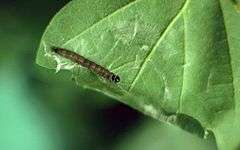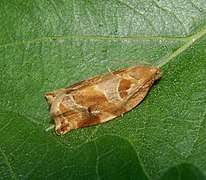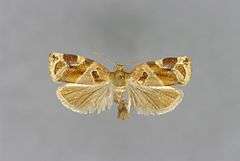Archips xylosteana
Archips xylosteana, the variegated golden tortrix or brown oak tortrix, is a moth of the family Tortricidae.
| Archips xylosteana | |
|---|---|
| Scientific classification | |
| Kingdom: | Animalia |
| Phylum: | Arthropoda |
| Class: | Insecta |
| Order: | Lepidoptera |
| Family: | Tortricidae |
| Genus: | Archips |
| Species: | A. xylosteana |
| Binomial name | |
| Archips xylosteana | |
| Synonyms | |
|
List
| |
Distribution
This Palearctic moth is widespread in most of Europe, in Asia (China, Iran, Japan, Kazakhstan, Korea, Siberia, Turkey), and in northern Africa (Algeria).[2][3][4]
Description
Archips xylosteana is a medium-sized to large moth with a wingspan reaching 14–23 millimetres (0.55–0.91 in).[6] The females are usually slightly larger than the males. The basic color of the fore wings varies from yellow-brown or ocher to pinkish brown, mottled with dark reddish brown markings. Forewings are broad and roughly rectangular. Hind wings are light grayish brown. [4] The design of the wings may appear lightly asymmetric, because at rest one of the wing covers the other[4] and hides part of it. The caterpillar varies from whitish gray to bluish with greenish reflections and have a black head. [4]
Biology
These moths fly from June to August in one generation.[4][6] They rest during the day in the foliage of trees and shrubs. Their activity begins at dusk. [6] They overwinter on tree trunks and thick boughs.
Caterpillars grow protected in a rolled leaf, perpendicularly to the midrib, from April to June. These larvae are polyphagous, feeding on various shrubs and deciduous trees, [4] mainly oak (Quercus), elm (Ulmus), Linden (Tilia), hazel (Corylus), maples (Acer), ash (Fraxinus, firs (Abies), brambles (Rubus), Honeysuckle (Lonicera) and St John's worts (Hypericum)). [5] They can also be found on various fruit trees (apple, pear, etc.) [7] and on some herbaceous plants.
Gallery
 Caterpillar
Caterpillar.jpg) Moth, side view
Moth, side view Moth, female
Moth, female Mounted specimen. Male
Mounted specimen. Male
Bibliography
- Linnaeus, C. (1758): Systema naturae per regna tria naturae, secundum classes, ordines, genera, species, cum characteribus, differentiis, synonymis, locis. Tomus I. Editio decima, reformata. 1-824. Holmiae (Laurentius Salvius).
- Robinson, G. S. & E. Schmidt Nielsen (1983): The Microlepidoptera described by Linnaeus and Clerck. — Systematic Entomology 8: 191-242.
References
| Wikispecies has information related to Archips xylosteana |
| Wikimedia Commons has media related to Archips xylosteana. |
- Tortricidae.com
- Funa europaea
- Revision of Tribe Archipini (Tortricidae: Tortricinae) in Northeast China
- IDtools
- "Suffolk Moths". Archived from the original on 2018-05-11. Retrieved 2018-05-11.
- UK Moths
- Historische Lepidopteren-Literatur / Schütze (1931)